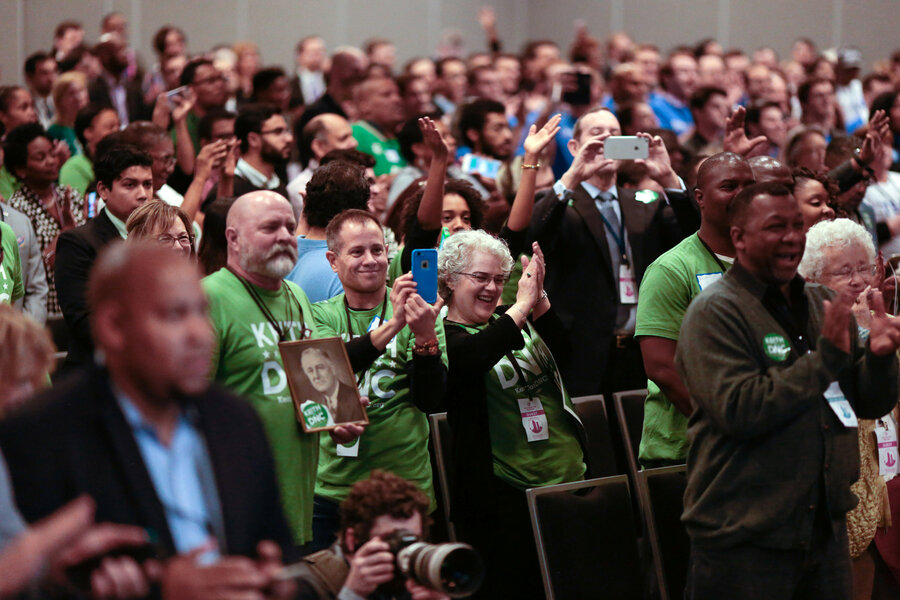Tom Perez, new DNC chair: Why this post matters
Loading...
The Democratic Party’s 447 National Committee members elected former Obama labor secretary Tom Perez to be their new party chair on Saturday, in an unusually contentious race for what amounts to the top job for a party in transition.
Mr. Perez, a favorite with the more centrist wing of the party allied with Hillary Clinton and Barack Obama, won 235 votes to the 200 captured by Rep. Keith Ellison (D) of Minnesota, a favorite with progressives who was leading slightly in polls coming into Saturday, according to CNN. The son of Dominican immigrants, Perez will become the first Latino to hold the post.
The chair takes the lead role in the party’s organizing, messaging, and fundraising operations, and thus has substantial clout in redefining the Democrats' identity and pitch to voters, following their shock loss in the presidential election.
The DNC chair election comes at a time when the Democrats enjoy as little political control as they have in nearly a century, having lost 20 percent of their Senate seats, 25 percent of their House seats, 45 percent of their governors, and over half of state legislatures since 2009, according to the Associated Press. Several candidates, including Perez, campaigned on a promise to concentrate more on down-ballot races, as well as ramp up small-donor fundraising.
But one of the most crucial questions for Perez may be how to interpret national demographic trends and translate them into Democratic strategy – itself a test of Democrats’ long-held notion that their future is assured by a natural-born coalition of minority and Millennial voters.
Some Democrats see more progressive white voters – ie the "Bernie voters," who viewed Hillary Clinton’s candidacy with skepticism – as the part of the electorate that the next DNC chair needs to target. Demographic trends, they argue, tilt electoral dynamics in their favor, and away from the white working-class voters who came out in unexpected force for President Trump.
"As Mrs. Clinton’s popular vote margin showed, there is still a new American majority made up of a meaningful minority of whites and an overwhelming majority of minorities,” wrote Steve Phillips, a senior fellow at the Center for American Progress who has written about demographic shifts and US politics.
"Not only is there little evidence that Democrats can do significantly better with those white working-class voters who are susceptible to messages laced with racism and sexism, but that sector of the electorate will continue to shrink in the coming years. Nearly half of all Democratic votes (46 percent) were not white in 2016, and over the next four years, 10 million more people of color will be added to the population, as compared with just 1.5 million whites,” he wrote in a New York Times op-ed this month.
But others think these numbers obscure movement happening below the surface.
The problem with the notion that Democrats will be able to fall back on demographic changes, say Lanae Erickson Hatalsky and Jim Kessler of the centrist think tank Third Way, is threefold: the changes are concentrated largely in urban Democratic strongholds, voters cast ballots across parties more often than believed, and the rising proportion of voters who identify as liberal is offset by other factors, including a corresponding rise in conservative-identifying voters.
“It is likely that this new path back to a majority will require winning more white voters,” they wrote in a recent report. "But more fundamentally, a new path to the majority will require targeting communications, policy ideas, and appeals based on values, beliefs, and experiences — not simply age or race."
Perez’s election to the post may come as a surprise to some who expected Mr. Ellison to prevail, partly as a concession to the progressive wing. Sen. Bernie Sanders (I) of Vermont, a backer of Ellison, had posed the choice as one between the “failed status quo” and a “fundamental restructuring of the Democratic Party,” notes the Washington Post.
"I’m worried,” said Jerry Shriner, a DNC member from Idaho, in a pre-vote interview with the Hill. "There are risks with every candidate, but [with Ellison and Perez] in particular … I think there will be people who pull back," he said.
"But the way I look at it, we have four years to work on that," he added. "Whatever problems either candidate might create in terms of divisiveness, we have four years to pull that together."








